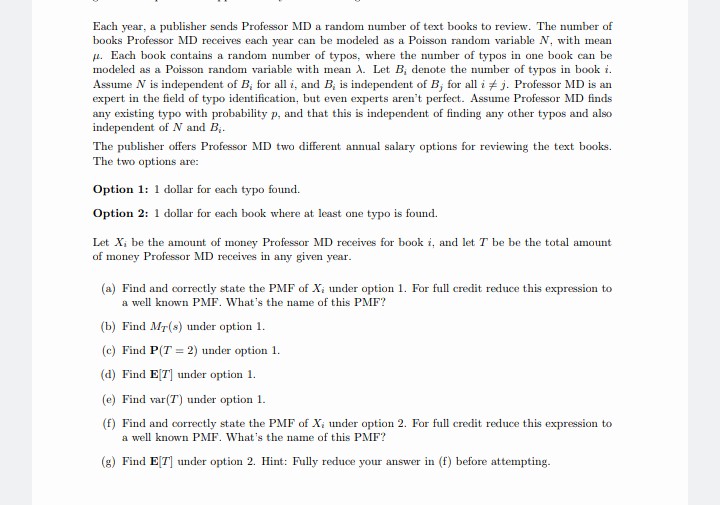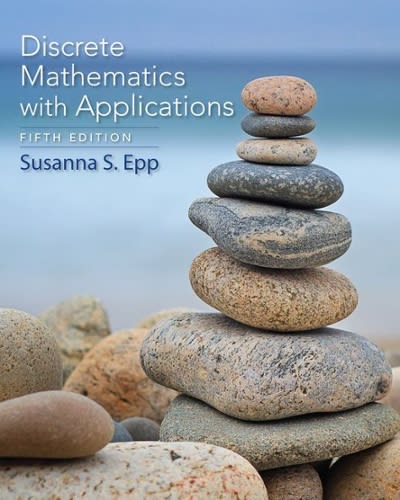

Kindly assist with this assignment
Jon and Stephen cannot help but think about their commutes using probabilistic modeling. Both of the them start promptly at Sam. Stephen drives and thus is at the mercy of traffic lights. When all traffic lights on his route are green, the entire trip takes 18 minutes. Stephen's route includes 5 traffic lights, each of which is red with probability 1/3, independent of every other light. Each red traffic light that he encounters adds 1 minute to his commute (for slowing, stopping, and returning to speed). 1. (10 points) Find the PMF, expectation, and variance of the length (in minutes) of Stephen's commute. 2. (10 points) Given that Stephen's commute took him at most 19 minutes, what is the expected number of red lights that he encountered? 3. (10 points) Given that the last red light encountered by Stephen was the fourth light, what is the conditional variance of the total number of red lights he encountered? 4. (10 points) Given that Stephen encountered a total of three red lights, what is the probability that exactly two out of the first three lights were red? Jon's commuting behavior is rather simple to model. Jon walks a total of 20 minutes from his home to a station and from a station to his office. He also waits for X minutes for a subway train, where X has the discrete uniform distribution on {0. 1, 2, 3). (All four values are equally likely, and independent of the traffic lights encountered by Stephen.) 5. (5 points) What is the PMF of the length of Jon's commute in minutes?' 6. (10 points) Given that there was exactly one person arriving at exactly 8:20am, what is the probability that this person was Jon? 7. (10 points) What is the probability that Stephen's commute takes at most as long as Jon's commute? 8. (10 points) Given that Stephen's commute took at most as long as Jon's, what is the conditional probability that Jon waited 3 minutes for his train?Each year, a publisher sends Professor MD a random number of text books to review. The number of books Professor MD receives each year can be modeled as a Poisson random variable N, with mean #. Each book contains a random number of typos, where the number of typos in one book can be modeled as a Poisson random variable with mean A. Let B, denote the number of typos in book i. Assume N is independent of B; for all i, and B; is independent of B, for all i # j. Professor MD is an expert in the field of typo identification, but even experts aren't perfect. Assume Professor MD finds any existing typo with probability p, and that this is independent of finding any other typos and also independent of N and Bi. The publisher offers Professor MD two different annual salary options for reviewing the text books. The two options are: Option 1: 1 dollar for each typo found. Option 2: 1 dollar for each book where at least one typo is found. Let Xi be the amount of money Professor MD receives for book i, and let T be be the total amount of money Professor MD receives in any given year. (a) Find and correctly state the PMF of X, under option 1. For full credit reduce this expression to a well known PMF. What's the name of this PMF? (b) Find My(s) under option 1. (c) Find P(T = 2) under option 1. (d) Find E[7] under option 1. (e) Find var(7) under option 1. (f) Find and correctly state the PMF of Xi under option 2. For full credit reduce this expression to a well known PMF. What's the name of this PMF? (g) Find E 7] under option 2. Hint: Fully reduce your answer in (f) before attempting.The continuous random variables X and Y have a joint pdf given by fxy(z, y) = c, if (r, y) belongs to the shaded region; otherwise. In class we have shown the minimum least squares estimate of Y is given by E[Y X = =] (a) Find the least squares estimate of Y given that X = z, for all possible values of r. For full credit write the functional form, as opposed to a graph. (b) Let g(x) be the estimate from part (a). Find Efg(X ]] and var(g(X]). (c) Find the mean square error E[(Y - 9(X))']. Is it the same as Elvar(Y|X)]? (d) Find var (Y)











